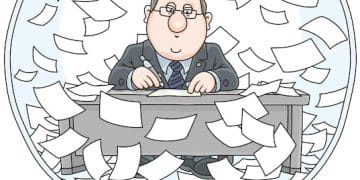Federal Student Loan Forgiveness Programs: 2025 Updates

Federal student loan forgiveness programs are continually evolving, and understanding their latest status is crucial as we approach 2025; this article explores the current landscape of these programs, eligibility criteria, potential changes, and what borrowers need to know to navigate them effectively.
Navigating the complex world of student loans can be daunting, especially when considering options like forgiveness programs; what’s the latest on federal student loan forgiveness programs in 2025?
Federal Student Loan Forgiveness: An Overview
Federal student loan forgiveness programs offer a lifeline to borrowers struggling to repay their debt; these programs, designed to address various financial hardships and public service commitments, have undergone significant changes recently.
Understanding the current state of these programs is essential for borrowers and policymakers alike; let’s explore the key elements and potential future directions of federal student loan forgiveness.
Types of Federal Student Loan Forgiveness Programs
Several federal student loan forgiveness programs cater to different circumstances; the most prominent include Public Service Loan Forgiveness (PSLF) and Income-Driven Repayment (IDR) forgiveness.
- Public Service Loan Forgiveness (PSLF): PSLF forgives the remaining balance on Direct Loans after 120 qualifying monthly payments made while working full-time for a qualifying employer.
- Income-Driven Repayment (IDR) Forgiveness: IDR plans, such as Income-Based Repayment (IBR), Pay As You Earn (PAYE), and Revised Pay As You Earn (REPAYE), offer forgiveness after 20 or 25 years of qualifying payments, depending on the plan.
- Teacher Loan Forgiveness: This program offers forgiveness of up to $17,500 for qualified teachers who teach full-time for five consecutive years in designated low-income schools.
These programs provide pathways to debt relief for borrowers in specific fields or with particular financial needs; however, each program has its own set of eligibility requirements and application processes.

Recent Changes to Student Loan Forgiveness Programs
The landscape of federal student loan forgiveness programs has been dynamic, with adjustments made to eligibility criteria and the overall process; these changes aim to streamline forgiveness and expand access to eligible borrowers.
Staying informed about these modifications is crucial for borrowers seeking to benefit from these programs; below are some of the recent updates and major changes.
Biden-Harris Administration Initiatives
The Biden-Harris administration has implemented several changes to improve student loan forgiveness; these include temporary waivers, expanded eligibility criteria, and efforts to address systemic issues within the loan servicing system.
The Supreme Court Decision and Its Aftermath
The Supreme Court’s decision to strike down the administration’s broad-based student loan forgiveness plan has significantly altered the landscape; in response, the administration has pursued alternative avenues for delivering relief to borrowers.
- New Income-Driven Repayment (IDR) Plan: The administration introduced the Saving on a Valuable Education (SAVE) plan, an IDR plan designed to lower monthly payments and provide faster forgiveness for low-income borrowers.
- Negotiated Rulemaking Process: The Department of Education is undergoing a negotiated rulemaking process to develop new regulations for student loan forgiveness.
These developments reflect the ongoing efforts to address student loan debt and provide meaningful relief to borrowers; however, navigating these changes requires careful attention to detail and clear communication.
Eligibility Criteria for Loan Forgiveness in 2025
Eligibility criteria for federal student loan forgiveness programs vary depending on the specific program; understanding these requirements is essential for borrowers to determine their eligibility and prepare their applications.
Let’s delve into the key eligibility factors for some of the main federal programs; PSLF, IDR, and Teacher Loan Forgiveness.
Public Service Loan Forgiveness (PSLF)
To qualify for PSLF, borrowers must be employed full-time by a qualifying employer, such as a government organization or a non-profit organization; qualifying employment is a key factor in determining eligibility.
Borrowers must also have Direct Loans and make 120 qualifying monthly payments under an income-driven repayment plan; adhering to these guidelines is crucial for PSLF eligibility.
- Qualifying Employment: Working full-time for a qualifying employer (government or non-profit).
- Direct Loans: Having loans that are part of the Direct Loan Program.
- Qualifying Payments: Making 120 monthly payments under an income-driven repayment plan.
Meeting these requirements can be complex, but careful attention to detail is essential for borrowers seeking PSLF; understanding each component ensures a higher likelihood of approval.
Income-Driven Repayment (IDR) Forgiveness
Eligibility for IDR forgiveness hinges on enrolling in an IDR plan and making qualifying payments over a specified period; the forgiveness timeline varies depending on the plan.
Plans such as IBR, PAYE, and REPAYE offer forgiveness after 20 or 25 years of qualifying payments; this provides a long-term pathway to debt relief for borrowers with income-related hardships.

Potential Changes and Future Outlook
The future of federal student loan forgiveness programs is subject to ongoing policy debates and potential legislative changes; understanding the possible directions these programs may take is crucial for borrowers.
As we look towards 2025, several factors could influence the evolution of loan forgiveness programs; economic conditions, political priorities, and borrower advocacy all play a role.
- Legislative Actions
- Economic Factors
- Borrower Advocacy and Policy Influence
Legislative actions could introduce new loan forgiveness programs or modify existing ones; economic factors, such as unemployment rates and inflation, could also impact eligibility criteria and repayment terms.
Borrower advocacy and policy influence can shape the debate around student loan forgiveness and drive reforms to improve access and outcomes; these areas create a dynamic environment that requires a holistic approach.
Expert Predictions for 2025
Experts predict continued efforts to streamline and expand access to loan forgiveness programs; this may include simplifying application processes and increasing awareness among eligible borrowers.
The focus on income-driven repayment plans and targeted relief for specific borrower populations is also expected to persist; these strategies reflect a commitment to addressing student loan debt in a sustainable and equitable manner.
How to Apply for Federal Student Loan Forgiveness
Applying for federal student loan forgiveness involves several steps, including understanding eligibility criteria, gathering necessary documentation, and submitting the application; a proactive approach can improve the likelihood of success.
Each loan forgiveness program has its own application process, so it’s important to consult the program’s guidelines carefully; here’s how to apply for PSLF specifically.
Step-by-Step Guide to Applying for PSLF
To apply for PSLF, borrowers must first ensure they meet the eligibility criteria, including qualifying employment and Direct Loans; the application process involves submitting the PSLF form to the Department of Education.
This form requires employer certification and information about the borrower’s loans and repayment history; accuracy and completeness are critical for a successful application, so pay attention to every detail and requirement.
- Verify Eligibility: Ensure you meet the qualifying employment and loan requirements.
- Gather Documentation: Collect necessary documents, including employment certification forms and loan statements.
- Submit the Application: Complete and submit the PSLF form to the Department of Education.
Following these steps carefully can help borrowers navigate the PSLF application process and increase their chances of receiving loan forgiveness; and keep track of timelines and expected approval periods.
Navigating the Complexities of Student Loans
The realm of student loans can be complex, and understanding the various programs and requirements is crucial for effective management; navigating these intricacies can save time and money.
Consider seeking expert advice, using available resources, and staying informed about policy changes; these actions can empower borrowers to make informed decisions and navigate their student loan journey with confidence.
“`html
| Key Point | Brief Description |
|---|---|
| 🎓 PSLF | Forgives loans for public service employees after 120 qualifying payments. |
| 💰 IDR Plans | Offers forgiveness after 20-25 years of income-driven payments. |
| 🍎 Teacher Loan Forgiveness | Provides up to $17,500 in forgiveness for eligible teachers in low-income schools. |
| 🔄 SAVE Plan | New IDR plan with lower monthly payments and faster forgiveness. |
Frequently Asked Questions
▼
PSLF forgives the remaining balance on your Direct Loans after you’ve made 120 qualifying monthly payments while working full-time for a qualifying employer, such as a government or non-profit organization.
▼
IDR plans, like IBR, PAYE, and REPAYE, adjust your monthly payments based on your income and family size; these plans offer forgiveness after 20 or 25 years of qualifying payments, depending on the plan.
▼
To apply for PSLF, you must submit the PSLF form to the Department of Education; this form requires employer certification and information about your loans and repayment history, ensuring accuracy is key.
▼
The Saving on a Valuable Education (SAVE) plan is a new IDR plan designed to lower monthly payments and provide faster forgiveness for low-income borrowers, making it a more affordable option.
▼
If your PSLF application is denied, review the reason for denial and correct any errors; you can also explore other forgiveness options, such as IDR plans, to find a suitable path to debt relief.
Conclusion
Staying informed about the evolving landscape of federal student loan forgiveness programs is essential for borrowers seeking debt relief; by understanding the eligibility criteria, recent changes, and application processes, borrowers can navigate these complexities and work towards a brighter financial future.





